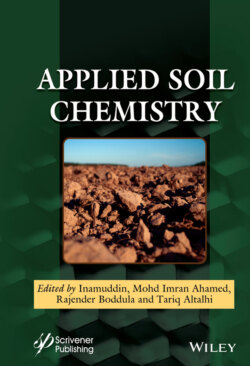Читать книгу Applied Soil Chemistry - Группа авторов - Страница 50
2.3.2.2 Leaching and Water Contribution
ОглавлениеWater has two unique roles as a chemical weathering agent. Firstly, water acts as a reactant in hydroxylation, i.e., hydrolysis reaction which is vital source for accumulated hydroxyl in feralitic hydroxyl oxides and layer silicates. The reaction mentioned above is exothermic in nature. Minerals hydration gives rise to enhancement in volume and hence acts as a significant factor in coarsely grained igneous rocks decaying, as reported by Rieche et al., in the year 1950 [8]. The second contribution of water is its role as leaching agent in internal drainage and flow of water allows the movement through the soil. The processes, leaching and hydroxylation, are connected to the extent that the hydrolysis products which are soluble should be eliminated for driving the reaction. Kellogg et al., in the year 1943 [16], reported that water is main agent of chemical weathering. Bayers et al., in the year 1933 [66–68], reported that the process of weathering completely expressed as hydrolysis reaction, but they also marked that the rate of process is affected by factors like specific nature of minerals, size of particles, movement of water, temperature, etc. Marbut et al., in the year 1951 [69–71], reported that rock decomposition product contains variably large quantity of combined water in comparison to materials which are not decomposed. Mineralogical analysis is the basis of hydroxyl occurrence, by direct hydroxyl determination as per Jackson and Evans et al., in the year 1952 [72–74], by weight loss as per Nutting et al., in the year 1943 [75–77], by differential thermal methods as per Rowland and Grim et al., in the year 1942 [78–80]. As per Jackson et al., in the year 1948 [37], it was reported that chemical weathering is driven by leaching which involves the elimination of few products which are formed and moreover ions leaching might be enough comprehensive that upcoming stages of weathering consists of varying elements chemically. Another important factor of leaching is calculation of solutes present in water of river. Polynov et al., in the year 1937 [5], and Smith et al., in the year 1913 [93–95], reported mobility of ions in comparative manner to describe abovementioned calculation. The order of ions in the increasing order includes HO3, SiO2, Mg, Na, and Ca. Further, by extending this study, Goldich et al., in the year 1938 [31], reported according to increasing order of loss, SiO2, I, Mg, Ca, and Na. It was considered that Al was neither lost or accumulated and combined water and iron was gained. Mohr et al., in the year 1944 [96–98], reported the significance of internal drainage due to leaching and reactions of weathering. The motion of water in the soil is controlled by drainage. As per Jackson et al., in the year 1948 [38], sediments of tourmaline, zircon, quartz, feldspar, and authigenic micas indicated reversal in a case when the ionic substances were abundantly existed in sea water.
